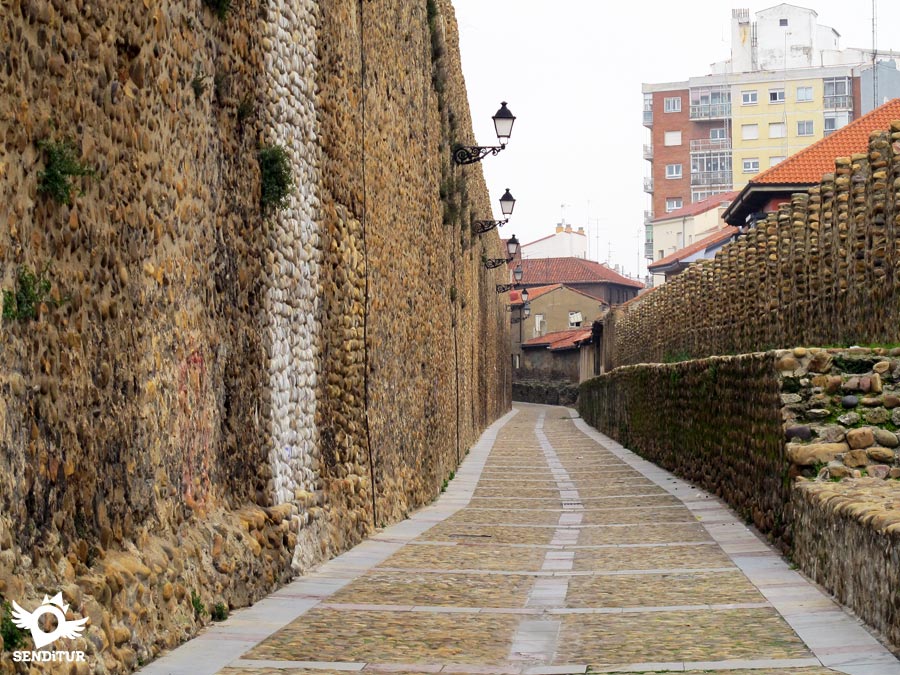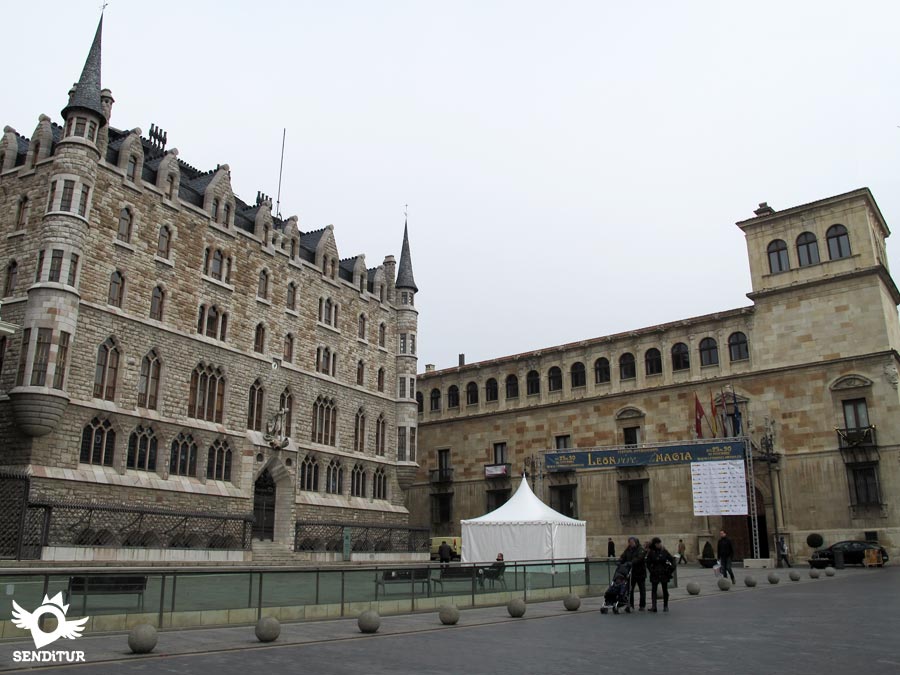It is located in an almost flat area, cradled and irrigated by the waters of the rivers Bernesga and Torío, the latter yielding its flow to the Bernesga after greeting the city. Since its foundation in the first century of our era, the city of León has kept a long and dense history in which each era has left its mark of character and culture. Its origin goes back to the times when the Legio VII Gemina settled here and its walled camp grew with villages of soldiers' relatives. Centuries later it was occupied by the Visigoths and around 712 it was conquered and fell under Arab rule until King Alfonso I the Catholic reconquered it. In the 9th century Ordoño I incorporated it into the Asturian kingdom and Ordoño II turned it into its capital, thus beginning the Kingdom of León.

The city developed and gained in splendour, partly due to the Jacobean route, which led to hospital facilities for pilgrims, monastic ensembles, churches ... The Muslims to the order of Almanzor destroyed the city in the middle of the 10th century. With Alfonso V, at the beginning of the 11th century, León saw how it was recovered and rebuilt, consolidating itself at the same time as a city, due to the fact that with this king the Christian reconquest began to lead to the definitive victory, although it was not entirely achieved until centuries later in the reign of the Catholic Monarchs. In 1230, with Ferdinand III the Saint, the kingdoms of Castilla and León were unified and the capital, which León held, became itinerant. In the middle of the same century his son Alfonso X the Wise ordered the construction of the new cathedral. After centuries of chiaroscuro of history, it was during the 18th century at the beginning of the 19th century when it received a new impulse with an important urban growth. León lived in its flesh, like the rest of the Spanish cities, the War of Independence and later the Civil War. In the second half of the twentieth century, between the 60s and 70s, the city, due to the boom in mining and industry, expanded urbanistically and today is a modern capital of its time that perfectly combines the dynamism present with its long years of history.

Walking through León is to find yourself in every corner, in every street, with a remarkable building, a monument, a chapel, a little piece of history that does not make you go unnoticed. If we start on the banks of the River Bernesga, the Hospital de San Marcos, with its impressive Plateresque façade, invites us to sit in the square of the same name and enjoy the sun while we admire it. We arrive at the Royal Collegiate Basilica of San Isidoro, according to the experts, the Sistine Chapel of Romanesque Art. Here were celebrated in 1188 the Cortes de León, the first Cortes in history. In the Square of San Marcelo there are monuments of different styles and periods; the Palace of Los Guzmanes of the XVI century; the House of Botine, work of Gaudí; the palace of the Marqués de Torreblanca of the XVII century; the old Town Hall of Renaissance style, or the church of San Marcelo, in its origin the oldest of the city, its reconstruction is of the XVI-XVII. Going up the Wide Street, the Pulchra leonina, the cathedral, impressive work of Spanish Gothic, where beauty and forms are harmonized. With spectacular façades full of sculptures, such as that of the White Virgin, that of San Froilán or the Virgin of Dado and inside the multicoloured light originated by its beautiful and numerous stained-glass windows, it does not allow us to stop looking upwards in an attempt to capture all its grandiosity.

The church of Nuestra Señora del Mercado, is one of the most important temples of the city for its antiquity, at the same time that it can be the one that is more united to the Way. Its many squares, such as the Grano or Town Square. Its walls, which although the current ones date from the 14th century, the original ones are lost at the dawn of the history of León, of the eleven gates that the Arch of the Prison or Gate of the Castle had, it is one of the best preserved. Its museums and cultural buildings complete the wandering through the history and art of this beautiful city which is given natural freshness by its walks through parks and gardens. We can not say goodbye to Leon without going through the Barrio Húmedo, the tour now takes us through a range of tascas and restaurants where you can taste the dishes, tapas and wines of the area that will brighten our bodies..
León celebrates San Froilán on 5 October, the date on which this beloved and important figure of his time died and who was appointed bishop of León by King Alfonso III at the request of the people. Upon his death he was buried in the Cathedral, in the sepulchre that Alfonso III had built for himself. The big week of the city, the main festivities, are those that are celebrated at the end of June, in honour of San Juan and San Pedro.

León is a city of deep-rooted traditions. In its festivals are present acts and events that know centuries of life and history, such as its Holy Week. Las Cantaderas, an act that commemorates the liberation of the legendary tribute of the one hundred maidens after the victory of the Christians over the Muslims in the Battle of Clavijo. Las Cabezadas, which is the name given to the event commemorating the offering made by the town council in the basilica of San Isidoro, and which gave rise to a verbal dispute with the cathedral chapter. In this dispute are always tied and postponed for next year. The greeting with which the councillors say goodbye are three bows with an exaggerated inclination, hence the name of the celebration. In addition, every Wednesday and Saturday León offers us its traditional market of agricultural products, which has been held in the Town Square since medieval times.
The patron saint of León is San Marcelo, a Roman centurion from the second half of the third century who died a martyr for embracing Christianity. Its festivity is celebrated on the 30th of October.

The Cathedral of León holds many mysteries, produces many sensations, elevates the mind and spirit and perhaps makes you notice new sensations. Maybe that's what happened to a vagabond not too long ago, he used to spend his days inside the Cathedral and at night he slept in its surroundings. One dawn he climbed its walls and breaking one of the stained glass windows he sneaked inside, right in the Chapel of the White Virgin, there is looking for a sepulchre, that of the infant Don Alfonso de Castilla, who according to this vagabond, is an evil one, a king turned into a vampire and the cause for him to hear those voices in his head calling and exhorting him to free León and his Cathedral from these beings. The vagabond went to this tomb with the only desire to stick a stake in his heart, but what he did was spend the night in front of the tomb talking to her? and then he went where he had entered without causing any further destruction. According to data from the time Don Alfonso, heir to the crown, was beheaded in 1317 by his brother in order to gain access to the throne, but his head was not buried along with his body, perhaps because in the Middle Ages they buried those who thought they could return, who did not die, as could be Dracula. And whether it is by chance or not, the infant Don Alfonso is the only one buried without a head in the whole temple.
León is reached by a large number of roads that connect it with the main capitals, such as the A-231 that connects it with Burgos as well as the AP-71 or the N-120 and the La Plata dual carriageway or the N-630 that connect it with the A-6 via Astorga and Benavente respectively, as well as the AP-66 and the N-630 that connect it to Oviedo to the north.
The different intercity bus companies that operate in León communicate it, as well as with localities in the province and the autonomous community, with cities and capitals in the rest of Spain. The León bus station is located at Avenida Ingeniero Sáenz de Miera S/N telephone 987 211 000.
The city of León can also be reached by train, as it has two railway stations, the station of León, which is managed by Adif, better known for the Renfe station, which hosts trains that make long-distance and high-speed lines, is located in Avenida de Palencia, telephone 902 240 202 and the station of Matallana, Feve, in Avenida Padre Isla, 48, telephone 987 225 919, which provides regional services to Bilbao and Transcantábrico.
León Airport is located in the municipality of Valverde de la Virgen, about 6 kilometres from the centre of León. It has daily flights to Madrid and Barcelona and in the summer it expands its offer.
SENDITUR is not responsible for any variation in the information described, as well as for the misuse of its guides and recommends that everyone be responsible and prudent in carrying out the activity. Likewise, we invite you to document yourself with books and specialized guides to complement the information described. From the commitment of SENDITUR with Nature and the respect to the balance of the environment, SENDITUR urges you to travel in a responsible way, with low environmental impact and respecting at all times the Natural, Cultural and Social environment wherever you go. For any suggestion, SENDITUR invites you to send an email to .
Continue watching …